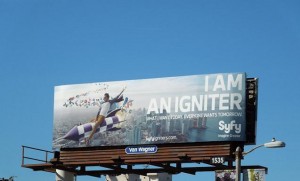Have you ever driven down Sunset Boulevard in Los Angeles? It’s an explosion of outdoor advertisements, all vying for our attention. I am big fan of outdoor; when properly executed, it’s a 24/7 avenue for invasive and creative communication. Colloquially, it’s art – amplified.
 A few weeks ago I was driving on Sunset, and noticed two advertisements from Syfy, the science fiction and fantasy programming cable network. They immediately caught my attention. Here are the ads:
A few weeks ago I was driving on Sunset, and noticed two advertisements from Syfy, the science fiction and fantasy programming cable network. They immediately caught my attention. Here are the ads:

 These advertisements intrigued me because they’re in the voice of the individual, not the brand. Whenever I see the word “I” in advertising, I’m drawn in. Someone is personally taking control of a message. To me, it is this ownership that can often times have more validity than a “buy me now message” from Budweiser or McDonald’s, for example.
These advertisements intrigued me because they’re in the voice of the individual, not the brand. Whenever I see the word “I” in advertising, I’m drawn in. Someone is personally taking control of a message. To me, it is this ownership that can often times have more validity than a “buy me now message” from Budweiser or McDonald’s, for example.
The marketer in me (I studied marketing in undergrad, and currently work in marketing at Universal Pictures) is constantly analyzing marketing communications of brands. I do my own personal assessment of what I think is working, what’s not, and what are the up and coming messaging trends. Brands are successful at marketing when they create an ad (via any channel) and entice the consumer to find out more. If a consumer is willing to do more research, invest their own time and energy, it’s a win in regards to initial communication strategy. As Young (2010) states in this week’s readings, this is where awareness, involvement, and active consideration can occur.
But with so much noise in the media landscape, messaging all too often comes and goes without any impact on the consumer. The Syfy ads stuck a chord with me, however. I saw the ads and immediately asked myself “Igniter? How does this relate to Syfy? I need to find out what this is about.” And to the internet I went.
What is an Igniter?
In January 2012, Syfy and research firms PSFK and Simmons partnered together to research today’s consumer. Based on the results, Syfy believes that the consumer is “more powerful today than ever (“Syfy uncovers, 2012).” But there is a particular type of consumer that the network has deemed powerful – the Igniter. But what defines an Igniter? Below are characteristics that the cable network believes describes this powerful consumer.
- Insatiable need to constantly be in-the-know about the latest and greatest everything.
- Must-have mentality drives them to try, do and buy the next big things.
- Vocal in telling everyone about their latest finds. Because they’re at the forefront, people listen to what they have to say.
- Optimistic
- Rethink Status Quo
- Inventive
- Risk Taker
- Creative
- Open-Minded
Take a look at the below video for a visual description of an Igniter.
Here’s a cull of the narration from the above ad.
An audience that lives for the next big thing. Who’s the first to try it, the first to buy it, and most importantly, the first to tell everyone about it. They’re Igniters. What they buy today, everyone wants tomorrow. And where do you find this audience? Syfy.
I like what Syfy is doing with this creative. What do you think? Does it work? I believe the ad does an effective job at integrating marketing into everyday life, and depicts Syfy as the place where brand advocates are located. According to the network, its programming (and subsequently its viewers) is advantageous for advertisers.
Essentially, the video ad tells me that brands move around, they are no longer static. This concept is very much in the vein of Young’s (2010) “liquid media” theory. Consumers (Igniters) have the power to propel a brand (“seamlessly”) through numerous channels, and to numerous audiences.
Selling the Igniter to Advertisers
Syfy’s Igniter campaign is ultimately a sales pitch to advertisers to buy media on the network. To help its case, the network does have leverage with several statistics.
In an 18-49 index by cable network, Syfy claims to be the “best place to find Igniters,” with a leading index of 112 (“Cable upfront,” 2012). Last year was the most-watched year ever, with an average of 1.2 million viewers in prime time 2011 (“Cable guide,” 2012). Lastly, “Syfy posted double-digit gains for men, women and adults in the first quarter of 2012 compared with the first quarter of 2011 (“Cable guide,” 2012).”
An Extension of Re-branding
It’s interesting to note that this is not the first time Syfy has gone through a re-branding stage.
In 2009, the SciFi channel went through a re-branding phase, where the network was renamed Syfy, and a new logo was born (Karpel, 2012). This was executed by David Howe, President of Syfy, all in an effort to deviate from perceptions that sci-fi programming is only viewed by males, and as a way to give the channel a fresh look keen on innovation. Howe states that the intention was to create a brand that “was extendable into new platforms (Karpel, 2012).” As leverage, Syfy.com just had its best year ever, with 3.7 million unique views and 30 million page views. The network also has a Facebook and Twitter account.
I remember not being a fan of the new Syfy logo. At first. I thought it was very pedestrian and didn’t speak to the core viewers. But over time the logo grew on me, and I can actually appreciate its meaning. It broadens the capabilities of the network, as the previous logo was very focused and suffocating in terms of creative potential. The new logo is open and diverse. Much like its programming and much like its audience.
No More Inside Walls
Author Chris Grams wrote a book in 2012 called The Ad-Free Brand. He discusses the rising power of the consumer, and the necessary actions of organizations to be accepting of this power.
The Syfy ads reminded me of Grams’ book because it embodies so many aspects of the author’s ideas. Here is a particularly important statement from Grams:
Brands are no longer built inside the walls of corporations, but instead they are built together by organizations and the communities of customers, contributors, partners, and detractors surrounding them (p.8).
The Igniter campaign creates a relationship between the network and the consumer. And the advertiser.
Cheers
Cheers to Syfy for being proactive in its communication with advertisers. The network is ultimately out to get business, just like any other organization. But this strategy is smart and definitely different than what I have seen from other networks. I would say Bravo is the only other network with comparable initiatives.
Syfy has taken what everyone “talks” about, and has put it in writing, into action.
Sources:
Cable guide 2012. (2012). Retrieved from http://brandedcontent.adage.com/cableguide2012/network.php?id=64
Grams, C. (2012). The ad-free brand. (p. 8). Indianapolis: Que.
Karpel, A. (2012). Syfy president dave howe on how to capture more diverse audiences. Retrieved from http://www.fastcocreate.com/1680084/syfy-president-dave-howe-on-how-to-capture-more-diverse-audiences
Syfy uncovers how highly imaginative people – igniters – move brands forward faster. (2012, January 18). Retrieved from http://www.thefutoncritic.com/news/2012/01/18/syfy-uncovers-how-highly-imaginative-people-igniters-move-brands-forward-faster-881203/20120118syfy01/
Young, A. (2010). Brand media strategy: Integrated communications planning in the digital era. New York: Palgrave Macmillan.



6 Responses to The “Igniter”